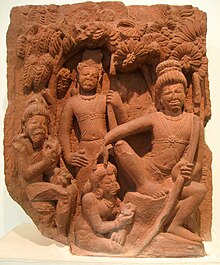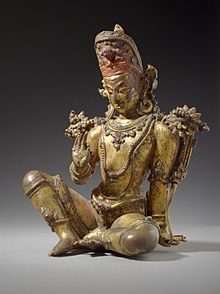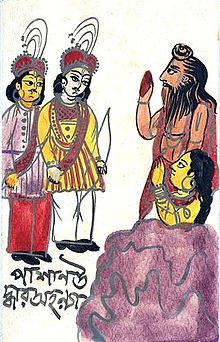Ahalya

According to historical records, Ahalya (Sanskrit: अहल्या, IAST Ahalyā), also known as Ahilya, is the wife of the sage Gautama Maharishi. Created by Lord Brahma as the most beautiful woman, Ahalya was married to the much older Gautama. Many Hindu scriptures say that she was seduced by Purandara, the current king of heaven (the post of king of heaven is also called Indra). Following this incident she was cursed by her husband for infidelity. Eventually, she was liberated from the curse by Lord Rama (an avatar of the Supreme Lord Krishna or Vishnu).
Quotes
[edit]
One should forever remember the panchakanya who are the destroyers of great sins. - Vaman Shivaram Apte.
- The well-known Sanskrit hymn that defines the Panchakanyas (five iconic heroines of Hindu epics) runs:
- Sanskrit transliteration IAST: ahalyā draupadī sītā tārā mandodarī tathā ।
pañcakanyāḥ smarennityaṃ mahāpātakanāśinī॥ - English translation: Ahalya, Draupadi, Sita, Tara and Mandodari
One should forever remember the Panchakanya who are the destroyers of great sins.- Vaman Shivaram Apte in: The Student's Sanskrit-English Dictionary, Motilal Banarsidass Publ., 1970, p. 73.
- Orthodox Hindus, especially Hindu wives, remember the Panchakanya in this daily morning prayer. Their names are extolled and the prayer is pratah smaraniya, prescribed to be recited in the early hours of the morning.
- Maharishi Vishvamitra narrated to them the story of Ahalya and Indra. The amorous Indra deceived Ahalya and raped her. When Muni Gautam came to know of this he cursed Indra to become hundred eyed and cursed Ahalya to survive on air and and lie in ashes for thosuands of years.
O, Rama! This is the forlorn ashram of that accursed Ahalya. Now that you have arrived here, I request to bless Ahalya and release her from her curse. On entering the ashram Rama came across Ahalya engaged in deep meditation. Ahalya was invisible to both humans and devas. Rama was the only person who could see her in all the three worlds.- P. Bansal in: Lord Rama, Diamond Pocket Books Pvt Ltd, 22 October 2014, p. 35.
- On seeing Rama, Ahalya's curse ended. Now she became visible to everybody. Recalling Maharshi Gautam's words, Ahalya received the princes with great affection. Ram accepted her hospitality wholeheartedly. With her powers of meditation Ahalya regained her true appearance. She was reunited with Maharishi Gautam with the intervention of Rama.
- P. Bansal in: "Lord Rama", p. 36S.
- Valmiki has not a word to say about the mother-son relationship between Ahalya and Shatananda. Ahalya’s son abandons her and lives comfortably in Janaka’s court, expressing relief that she is finally acceptable in society following Rama’s visit.
- Pradip Bhattacharya in: Living by Their Own Norms Unique Powers of the Panchkanyas, manushi-india.org.

- Along his journey Rama freed Ahalya from her curse. The grace of God is so strong it can free us from the most difficult situations. Through it our inner wisdom, symbolized by the sage's wife, can be released from the stone of ignorance and materialism in which it is trapped. But for this to occur, we must open ourselves to the Divine Will. Otherwise obstacles will arise that we cannot possibly overcome by our power.
- David Frawley in: The Oracle of Rama , Lotus Press, 1 November 2000, p. 53
- Born in a family of culture and having married a sage of distinction, her [Ahalya] mind faltered for a moment and she committed a grave sin and incurred a curse. Why should she commit this mistake? There lie the lessons for others.
- The Hindu in: Lessons from the Ahalya episode, The Hindu, 30 September 2002.
- However, on expressing her regret over the fault, the curse was lifted when the dust particles from the feet of Rama fell on her.
- The Hindu in: "Lessons from the Ahalya episode".
- Expressions of such a sincere regret enabled Ahalya to get back her form when God came in person to the place where she was spending her days "unseen". Our sins and taints in our souls will be wiped out by our appealing to the mercy of the Lord who will pardon our misdeeds. What Ahalya did was unpardonable and Sage Gautama, naturally enraged at her misconduct, condemned her. On her repentance, the sage said by offering hospitality to Rama, she would be freed from covetousness and delusion. He punished the celestial king [Indra] too, who was equally responsible for having misled her. It was to the sage's hermitage Rama paid a visit and made Ahalya regain her original form.
- Jaya Srinivasan in The Hindu in: "Lessons from the Ahalya episode".
- Ahalya in Ramayana became a victim of Indra’s lust and had to face the wrath of her husband sage Gowthama, who cursed her to turn into a stone.
- Gudipoodi Srihari in: Story of five archetypes, The Hindu, 30 May 2008
Expiation of sin
[edit]
Jaya Srinivasan in The Hindu in:Expiation of sin, The Hindu, 25 June 2010
- There is a price attached to every transgression and this is applicable to not only mortals but also to the celestials or the realised souls. The Ahalya episode exemplifies the extent of damage that desire (on Indra's part) and ego/pride (of Ahalya) wrought upon them.
- Sage Vishwamitra goes back in time to relate the painful incident in Ahalya's life to Lord Rama and Lakshmana when, on their way to Mithila, they reached a beautiful hermitage that permeated with an air of sanctity but was uninhabited. This hermitage had belonged to sage Gautama who had lived there with his wife Ahalya.
- Ahalya was created by Brahma as a woman of flawless beauty and though many wished to win her hand, Gautama, one of the revered Seven Sages was chosen to be her husband. Among the many disappointed admirers of Ahalya was Indra, whose longing for her almost became an obsession. He hence waited for an opportune moment to ravish her.
- While Ahalya and Gautama remained devoted to each other, Indra was unable to contain his desire for her. One night, he simulated the approach of dawn by imitating the cock's crow to lure Gautama to the Ganga for his morning ablutions. He then took Ahalya in the guise of Gautama. Ahalya was initially surprised at the quick return of her husband but was sharp enough to recognise Indra's disguise. Yet she acquiesced in to his desire. In fact, being conscious of her beauty, she was proud to have been desired by Indra himself.
- An enraged Gautama, who divined this unacceptable deed, cursed both Indra and Ahalya. Indra lost his manliness while Ahalya was cursed to remain invisible in the hermitage along with the dust without food for thousands of years until such time when the curse would be lifted with Rama's arrival there. She would then honour Lord Rama as a guest and then regain her pristine purity and be reunited with Sage Gautama.
Five Holy Virgins, Five Sacred Myths A Quest for Meaning
[edit]


Pradip Bhattacharya in: Five Holy Virgins, Five Sacred Myths A Quest for Meaning,manushi-india.org
- There is an ancient exhortation in naming five maidens as pratah-smaraniya, urging that they be invoked daily at dawn:
- Sanskrit transliteration IAST: Ahalya Draupadi Kunti Tara
Mandodari tatha
Panchakanya smaranityam
mahapataka nashaka - English translation: Ahalya, Draupadi, Kunti, Tara and Mandodari:
constantly remembering these virgins five destroys great failings.
- ...the unusual combination of names that redeem, of whom at least two – Ahalya andDraupadi – are ayonijasambhava meaning "not-of-woman-born".
- Of this group three – Ahalya, Tara, and Mandodari – belong to the Ramayana, the epic composed by Valmiki.
- It is the nobility of her character, her extraordinary beauty and the fact of her being chronologically the first kanya that places Ahalya at the head of the five virgin maidens. She had been true to her independent nature, fulfilling her womanhood in a manner that she found appropriate, though, finally, she is unable to assert herself.
- The name Ahalya itself has a double meaning: one who is flawless; it also means un-ploughed, that is, one who is a virgin. Her origin-myth states that, having created this flawless beauty from what was unique and loveliest in all creatures, Brahma handed her over to the sage Gautama for safe custody until she reached puberty.
- When Gautama handed her back to the Creator, he was so pleased with the sage’s self-restraint that he bestowed Ahalya upon him. Indra, lord of the gods, enamoured of her beauty, had presumed that this loveliest of women was meant for him and resented a forest-dwelling ascetic becoming her spouse.
- Vishvamitra tells Rama and Lakshmana that, assuming Gautama’s form in his absence, Indri approached Ahalya saying,
- Those craving coitus cannot wait; I crave union, slim-waisted one!...
- Indra said after approaching Ahalya
- I am gratified. Now leave this place quickly, best of gods! Protect yourself and me from Gautama in every way.
- Ahalya to Indra after she granted him sexual favours
- As Indra was leaving, however, Gautama returned. By his curse, Indra’s testicles fell off. Another version in the Mahabharata states that Indra’s beard was turned yellow by the curse. Ahalya was condemned to perform penance in that terrible forest, hidden from all, fasting (“subsisting on air”), sleeping in ashes, tormented by guilt. Gautama ordained that, purified of delusion (lobhamohavivarjita), by offering hospitality to Rama, she, fairest of all(varavarnini) would be redeemed to rejoin him.
- Creation’s sole beautiful woman, she is the archetypal feminine responding to the ardent, urgent, direct sexual advances of the ruler of heaven who presents such a dazzling contrast to her ascetic, aged, forest-dwelling husband. Ahalya already had a son, Shatananda, yet the deepest urges of her femininity remained unfulfilled.
- The Uttara Kanda version [Ramayana] is exculpatory, as may be expected of a later addition to the epic. Here Agastya states that, infuriated at Brahma bestowing Ahalya upon Gautama, Indra raped her, thus absolving Ahalya of any active role in the liaison. Gautama cursed Indra to suffer imprisonment (by Meghanada), bear half the guilt of every act of rape and lose all peace of mind. As for Ahalya, she would cease to be unique as the only beautiful female – other lovely women would be born. (That is why men fall in love with different women, projecting their anima on to them.) When Ahalya protested that she could not recognise the disguised Indra and was not guilty of wilful wickedness, Gautama relented and said that he would take her back after she had been purified through Rama accepting her hospitality.
- In the Mahabharata version, stated in the Shanti Parva, where the furious Gautama commands his son Chirakari to slay his polluted mother. But later regrets his rash command, realising that the fault lies not with his wife but with the lustful Indra. The Brahma Purana has Gautama turn Ahalya into a dry stream and disfigure Indra – who, terrified, has become a cat – with a thousand marks of the vulva. When Ahalya pleads her ignorance, Gautama grants her redemption upon her mingling with the Gautami River. By bathing in the same river, the marks on Indra’s body turn into eyes and he becomes “thousand-eyed” like the Greek Argus.
- The Katha-Sarit-Sagara version provides a clue to the psychological condition of Ahalya. The story is told to illustrate how evil acts lead to suffering for evildoers. On Gautama’s return, as in the Brahma Purana, Indra flees in the form of a cat and is cursed to be covered with the marks of the vulva he had so coveted. Replying to the sage’s enquiry about who had been in the cottage, Ahalya dissimulates, saying that it was a majjara (in Prakrit meaning both “cat” or “my lover”, because of which a synonym for Indra is Ahalyayaijara). She is punished by being turned to stone, reflecting the social ostracism of transgressing women and their consequent psychological trauma.
- Rama, at Vishvamitra’s behest, regards her as blameless and inviolate, as her name connotes. When he and Lakshmana touch her feet in salutation, this recognition restores her self-respect and her status in society, so that she truly lives again.
- Vishvamitra repeatedly refers to Ahalya as mahabhaga, most virtuous and noble – [for him] Ahalya was not a fallen woman.
- The Creator, it seems, with utmost care
had perfected this form,
divine, enchanting.
Like a tongue of flame
smoke-shrouded,
Like the full moon’s glory
ice-reflected,
Like blinding sunlight
mirrored in water.
- Gautama cursed his impotence and raged…
she stood petrified…
uncomprehending…
in stony silence...
withdrawn into the secret cave...
of her inviolate inner self....
she had her shelter....
sanctuary...
benediction...
within, perfect, inviolate…
in the one-ness of spirit...
with rock rain and wind...
with flowing tree...
and ripening fruit
and seed that falls silently...
in its time...
into the rich dark earth.- Chandra Rajan, a poetess of modern times

- What were your dreams,
Ahalya, when you passed
Long years as stone,
rooted in earth, prayer
And ritual gone,
sacred fire extinct
In the dark, abandoned forest-shram? Earth
Merged with your body;
did you know her vast
Love, did hazy awareness
haunt your stone?
...And keep you blindly, dimly,
half-awake?
...When life’s excited zest
Rushed along branching paths
in numerous forms
To conquer the desert, did it
rise in outrage,
Circle your stone and crush
your sterile curse?
Didn’t its pounding blows
shake you awake?...
Did you, long asleep on her
breast, enter
That place of oblivion, cool as
endless night,
Where millions sleep forever
without fear,
Resting their life’s exhaustion
in the dust,
Where withered flowers fall in
the day’s heat,
Burnt-up stars and meteors,
crumbled fame,
Sated pleasure, grief too tired
to sting?
There, Earth smoothed with
her soothing hand
Your lines of sin and stress. Today
you shine
Like a newly woken princess, calm
and pure.
You stare amazed at the dawn
world. The dew
Which moistened your stone at
night shimmers now
On your black, loosely-flowing hair.
The mosses
Which clothed you with the green
mantle of Earth,
Thickened and brightened by each
fall of rain,
Are now a sari lightly placed by a
mother’s
Loving hand on your glorious
naked limbs.
The world smiles; you
recognise that smile.
You gaze; your heart swings
back from the far past,
Traces its lost steps. In a sudden rush,
All round, your former
knowledge of life returns...
Like first
Created dawn, you slowly rise
from the blue
Sea of forgetfulness. You stare
entranced;
The world, too, is speechless;
face to face
Beside a sea of mystery none
can cross
You know afresh what you
have always known.- In Rabindranath Tagore’s poem “Ahalya” in Bengali translated by William Radice
- In Shiva Purana, Ahalya in an incident said to have occurred in another epoch (yuga). During a hundred year drought, Gautama’s ascetics resulted in Varuna gifting him an inexhaustible well, because of which his hermitage became a refuge for the distressed, including the Seven Sages. The wives of the Seven Sages abused Gautama’s disciples, insisting on having access to the well first. When Ahalya went to resolve the dispute, they abused her as well and lied to their husbands about what had happened. Blinded by passion for their wives, these sages turned to Ganesha, the vighna-karta, god of obstacles. They had him turn into an illusory cow that fell dead at Gautama’s touch, whereupon they stoned Ahalya and Gautama, driving them out of the hermitage. Shiva cursed the sages and their wives to be outside the Vedic pale, dooming them to perdition. Here Ahalya is a foil to the wickedness of the sages’ wives, instead of being the ‘fallen’ one.
Encyclopaedia of the Hindu World, Volume 1
[edit]Gaṅgā Rām Garg]] in: Encyclopaedia of the Hindu World, Volume 1, Concept Publishing Company, 1992, p. 236
- After Rama had touched the stone, she was transformed into the self same Ahalya. Rama reconciled her with Gautama. Ahalya and Gautama lived in the same hermitage again for another long period. This seduction is explained mythically...as Indra [the sun’s] carrying away the shades of night, Ahalya signifying night.
- Before Gautama had cursed Ahalya she had a son, named Satananda who was Upadhyaa (Guru] at the Rajas of the Nimi dynasty. She had a brother Divodasa, who was the king of Uttara Panchala. Ahalya had asked Uttanka, a disciple of Gautama to bring the ear-rings of the queen of Saudasa, in which task was successful. In the Vedas, Indra has been called the ‘lover of Ahalya’, which shows that the episode of Indra-Ahalya is only mythical.
- Certain modern scholars are of the view that Ahalya stands for 'barren land' and when Rama redeemed Ahalya, it means that Rama made the land of the south as fertile.
- In the Ahalya (Kannada) poetic drama: The gross in the natures of both Gautama and Ahalya – the ambition of the one and the temptation of the other - has been cured through cathartic experience. Sage Gautama, after giving Ahalya a son, named Satananda, is inspired by the ambition to acquire through penance the power to master the three worlds. In the process he starves his young wife’s natural longings. The Cupid is trying hard to distract Gautama. In the meantime finding Ahalya alone and so almost deserted by her husband, [[w:Indra|Indra approaches Ahalya. She too all along had admired Ahalya. Finding herself torn between duty and desire, she finally yields to Indra, just when Gautama, wheedled by Cupid, breaks his vow and approaches her. He comes to love but finding that he has lost both his love and vow, he curses her to an invisible existence feeding on air until Rama should arrive to redeem her and walks away to regain his lost peace of mind.
- Gaṅgā Rām Garg in: Encyclopaedia of the Hindu World, Volume 1, Concept Publishing Company, 1992, p. 236

